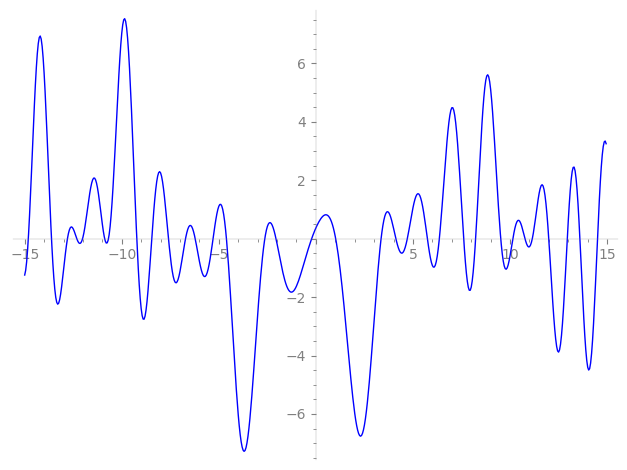| L(s) = 1 | + (−2.07 − 2.07i)3-s + (−0.707 + 0.707i)5-s + 4.34i·7-s + 5.59i·9-s + (−2.66 + 2.66i)11-s + (0.482 + 0.482i)13-s + 2.93·15-s + 0.353·17-s + (−5.39 − 5.39i)19-s + (9.00 − 9.00i)21-s − 6.62i·23-s − 1.00i·25-s + (5.38 − 5.38i)27-s + (3.42 + 3.42i)29-s − 0.635·31-s + ⋯ |
| L(s) = 1 | + (−1.19 − 1.19i)3-s + (−0.316 + 0.316i)5-s + 1.64i·7-s + 1.86i·9-s + (−0.803 + 0.803i)11-s + (0.133 + 0.133i)13-s + 0.757·15-s + 0.0856·17-s + (−1.23 − 1.23i)19-s + (1.96 − 1.96i)21-s − 1.38i·23-s − 0.200i·25-s + (1.03 − 1.03i)27-s + (0.636 + 0.636i)29-s − 0.114·31-s + ⋯ |
\[\begin{aligned}\Lambda(s)=\mathstrut & 1280 ^{s/2} \, \Gamma_{\C}(s) \, L(s)\cr =\mathstrut & (-0.608 + 0.793i)\, \overline{\Lambda}(2-s) \end{aligned}\]
\[\begin{aligned}\Lambda(s)=\mathstrut & 1280 ^{s/2} \, \Gamma_{\C}(s+1/2) \, L(s)\cr =\mathstrut & (-0.608 + 0.793i)\, \overline{\Lambda}(1-s) \end{aligned}\]
Particular Values
| \(L(1)\) |
\(\approx\) |
\(0.3698950574\) |
| \(L(\frac12)\) |
\(\approx\) |
\(0.3698950574\) |
| \(L(\frac{3}{2})\) |
|
not available |
| \(L(1)\) |
|
not available |
\(L(s) = \displaystyle \prod_{p} F_p(p^{-s})^{-1} \)
| $p$ | $F_p(T)$ |
|---|
| bad | 2 | \( 1 \) |
| 5 | \( 1 + (0.707 - 0.707i)T \) |
| good | 3 | \( 1 + (2.07 + 2.07i)T + 3iT^{2} \) |
| 7 | \( 1 - 4.34iT - 7T^{2} \) |
| 11 | \( 1 + (2.66 - 2.66i)T - 11iT^{2} \) |
| 13 | \( 1 + (-0.482 - 0.482i)T + 13iT^{2} \) |
| 17 | \( 1 - 0.353T + 17T^{2} \) |
| 19 | \( 1 + (5.39 + 5.39i)T + 19iT^{2} \) |
| 23 | \( 1 + 6.62iT - 23T^{2} \) |
| 29 | \( 1 + (-3.42 - 3.42i)T + 29iT^{2} \) |
| 31 | \( 1 + 0.635T + 31T^{2} \) |
| 37 | \( 1 + (-3.13 + 3.13i)T - 37iT^{2} \) |
| 41 | \( 1 + 2.33iT - 41T^{2} \) |
| 43 | \( 1 + (-7.59 + 7.59i)T - 43iT^{2} \) |
| 47 | \( 1 + 5.41T + 47T^{2} \) |
| 53 | \( 1 + (-4.49 + 4.49i)T - 53iT^{2} \) |
| 59 | \( 1 + (9.46 - 9.46i)T - 59iT^{2} \) |
| 61 | \( 1 + (6.21 + 6.21i)T + 61iT^{2} \) |
| 67 | \( 1 + (0.362 + 0.362i)T + 67iT^{2} \) |
| 71 | \( 1 + 7.32iT - 71T^{2} \) |
| 73 | \( 1 + 10.3iT - 73T^{2} \) |
| 79 | \( 1 - 8.13T + 79T^{2} \) |
| 83 | \( 1 + (-8.41 - 8.41i)T + 83iT^{2} \) |
| 89 | \( 1 - 4.55iT - 89T^{2} \) |
| 97 | \( 1 - 2.17T + 97T^{2} \) |
| show more | |
| show less | |
\(L(s) = \displaystyle\prod_p \ \prod_{j=1}^{2} (1 - \alpha_{j,p}\, p^{-s})^{-1}\)
Imaginary part of the first few zeros on the critical line
−9.225275478462835859459202195534, −8.455135044216723036228804686372, −7.59300054745118355724138874830, −6.71538404150209752952730361701, −6.21838126424111555267841270415, −5.29764018055760203487068828638, −4.60846856672202946288491677246, −2.63170040851355188185723719581, −2.05630458421478578062995732522, −0.21861263099550602160385757970,
1.01855608609130035749699547431, 3.35744883822025981305804682954, 4.11989636679526359674266323276, 4.70770728799478671547119180847, 5.74289556948023748374876156718, 6.35764751163062124893671260913, 7.61201307802128939178844446738, 8.226739380736140537684776032875, 9.521748221263370924392629227421, 10.14636424624556039010278072755

